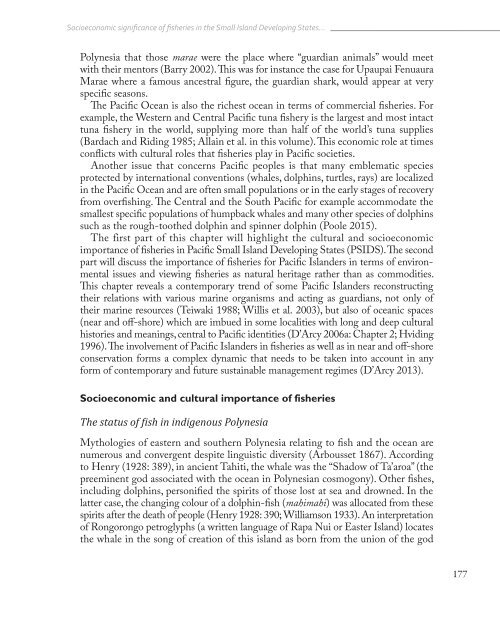Fisheries in the Pacific
Fisheries_in_the_Pacific
Fisheries_in_the_Pacific
Create successful ePaper yourself
Turn your PDF publications into a flip-book with our unique Google optimized e-Paper software.
Socioeconomic significance of fisheries <strong>in</strong> <strong>the</strong> Small Island Develop<strong>in</strong>g States…<br />
Polynesia that those marae were <strong>the</strong> place where “guardian animals” would meet<br />
with <strong>the</strong>ir mentors (Barry 2002). This was for <strong>in</strong>stance <strong>the</strong> case for Upaupai Fenuaura<br />
Marae where a famous ancestral figure, <strong>the</strong> guardian shark, would appear at very<br />
specific seasons.<br />
The <strong>Pacific</strong> Ocean is also <strong>the</strong> richest ocean <strong>in</strong> terms of commercial fisheries. For<br />
example, <strong>the</strong> Western and Central <strong>Pacific</strong> tuna fishery is <strong>the</strong> largest and most <strong>in</strong>tact<br />
tuna fishery <strong>in</strong> <strong>the</strong> world, supply<strong>in</strong>g more than half of <strong>the</strong> world’s tuna supplies<br />
(Bardach and Rid<strong>in</strong>g 1985; Alla<strong>in</strong> et al. <strong>in</strong> this volume). This economic role at times<br />
conflicts with cultural roles that fisheries play <strong>in</strong> <strong>Pacific</strong> societies.<br />
Ano<strong>the</strong>r issue that concerns <strong>Pacific</strong> peoples is that many emblematic species<br />
protected by <strong>in</strong>ternational conventions (whales, dolph<strong>in</strong>s, turtles, rays) are localized<br />
<strong>in</strong> <strong>the</strong> <strong>Pacific</strong> Ocean and are often small populations or <strong>in</strong> <strong>the</strong> early stages of recovery<br />
from overfish<strong>in</strong>g. The Central and <strong>the</strong> South <strong>Pacific</strong> for example accommodate <strong>the</strong><br />
smallest specific populations of humpback whales and many o<strong>the</strong>r species of dolph<strong>in</strong>s<br />
such as <strong>the</strong> rough-too<strong>the</strong>d dolph<strong>in</strong> and sp<strong>in</strong>ner dolph<strong>in</strong> (Poole 2015).<br />
The first part of this chapter will highlight <strong>the</strong> cultural and socioeconomic<br />
importance of fisheries <strong>in</strong> <strong>Pacific</strong> Small Island Develop<strong>in</strong>g States (PSIDS). The second<br />
part will discuss <strong>the</strong> importance of fisheries for <strong>Pacific</strong> Islanders <strong>in</strong> terms of environmental<br />
issues and view<strong>in</strong>g fisheries as natural heritage ra<strong>the</strong>r than as commodities.<br />
This chapter reveals a contemporary trend of some <strong>Pacific</strong> Islanders reconstruct<strong>in</strong>g<br />
<strong>the</strong>ir relations with various mar<strong>in</strong>e organisms and act<strong>in</strong>g as guardians, not only of<br />
<strong>the</strong>ir mar<strong>in</strong>e resources (Teiwaki 1988; Willis et al. 2003), but also of oceanic spaces<br />
(near and off-shore) which are imbued <strong>in</strong> some localities with long and deep cultural<br />
histories and mean<strong>in</strong>gs, central to <strong>Pacific</strong> identities (D’Arcy 2006a: Chapter 2; Hvid<strong>in</strong>g<br />
1996). The <strong>in</strong>volvement of <strong>Pacific</strong> Islanders <strong>in</strong> fisheries as well as <strong>in</strong> near and off-shore<br />
conservation forms a complex dynamic that needs to be taken <strong>in</strong>to account <strong>in</strong> any<br />
form of contemporary and future susta<strong>in</strong>able management regimes (D’Arcy 2013).<br />
Socioeconomic and cultural importance of fisheries<br />
The status of fish <strong>in</strong> <strong>in</strong>digenous Polynesia<br />
Mythologies of eastern and sou<strong>the</strong>rn Polynesia relat<strong>in</strong>g to fish and <strong>the</strong> ocean are<br />
numerous and convergent despite l<strong>in</strong>guistic diversity (Arbousset 1867). Accord<strong>in</strong>g<br />
to Henry (1928: 389), <strong>in</strong> ancient Tahiti, <strong>the</strong> whale was <strong>the</strong> “Shadow of Ta’aroa” (<strong>the</strong><br />
preem<strong>in</strong>ent god associated with <strong>the</strong> ocean <strong>in</strong> Polynesian cosmogony). O<strong>the</strong>r fishes,<br />
<strong>in</strong>clud<strong>in</strong>g dolph<strong>in</strong>s, personified <strong>the</strong> spirits of those lost at sea and drowned. In <strong>the</strong><br />
latter case, <strong>the</strong> chang<strong>in</strong>g colour of a dolph<strong>in</strong>-fish (mahimahi) was allocated from <strong>the</strong>se<br />
spirits after <strong>the</strong> death of people (Henry 1928: 390; Williamson 1933). An <strong>in</strong>terpretation<br />
of Rongorongo petroglyphs (a written language of Rapa Nui or Easter Island) locates<br />
<strong>the</strong> whale <strong>in</strong> <strong>the</strong> song of creation of this island as born from <strong>the</strong> union of <strong>the</strong> god<br />
177


